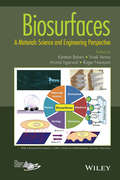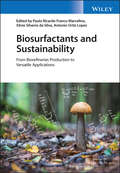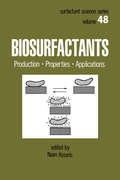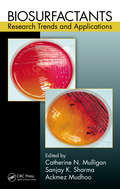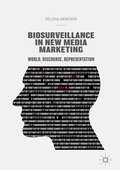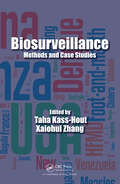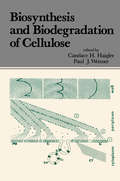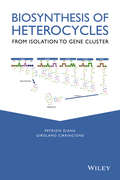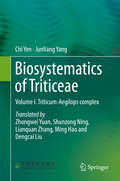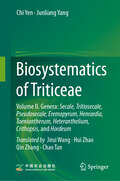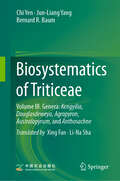- Table View
- List View
Biosurfaces
by Roger Narayan Kantesh Balani Arvind Agarwal Vivek VermaIdeal as a graduate textbook, this title is aimed at helpingdesign effective biomaterials, taking into account the complexinteractions that occur at the interface when a synthetic materialis inserted into a living system. Surface reactivity,biochemistry, substrates, cleaning, preparation, and coatingsare presented, with numerous case studies and applicationsthroughout. Highlights include:Starts with concepts and works up to real-life applicationssuch as implantable devices, medical devices, prosthetics, and drugdelivery technologyAddresses surface reactivity, requirements for surface coating,cleaning and preparation techniques, and characterizationDiscusses the biological response to coatingsAddresses biomaterial-tissue interactionIncorporates nanomechanical properties and processingstrategies
Biosurfactants and Biotechnology (Surfactant Science Ser. #25)
by KosaricHere is the first comprehensive reference to examine microbial surface active agents (biosurfactants)and biological emulsifiers as applied in biotechnology and other industries.Biosurfactants and Biotechnology highlights state-of-the-art uses of these agents, and incorporatesa wealth of ideas for future research and development related to feedstocks, production,and processing. The book delineates the chemistry, biochemistry, mechanisms, and propertiesof biosurfactants and biological emulsifiers .. . critically assesses their role in enhanced oil recoveryand other industrial applications . .. and includes numerous references to the literature.Biosurfactants and Biotechnology is an invaluable guide for physical, surface, and colloidchemists working on or with surfactants, interfacial phenomena, and cell-surface physiology ;petrochemical, chemical, biochemical, petroleum, and pollution control engineers; pharmacologists,cosmetic scientists, food scientists, and microbiologists. It is also an important resourcefor graduate students in these fields.
Biosurfactants and Sustainability: From Biorefineries Production to Versatile Applications
by Paulo Ricardo Franco Marcelino Silvio Silverio da Silva Antonio Ortiz LopezBiosurfactants and Sustainability A timely and authoritative collection of resources on the sustainable production of biosurfactants In Biosurfactants and Sustainability, a team of distinguished researchers presents emerging themes in the rapidly evolving field of biosurfactants. The editors have chosen work that focuses on biosurfactants as eco-friendly and versatile compounds of interest in societies seeking sustainable forms of development. The book examines biosurfactants in the context of biorefineries and in the exploration of extremophilic microorganisms for biosurfactant production. The included works discuss biosurfactant production from different lignocellulosic and amylaceous raw materials, as well as oilseeds and other agro-industrial byproducts. Readers will also find: A thorough introduction to microorganisms producing biosurfactants, as well as sustainable biosurfactant production in biorefineries Comprehensive explorations of the challenges of biosurfactant production in fermentation processes Practical discussions of bioreactors and metabolic engineering used in biosurfactant production Fulsome treatments of biosurfactant production using enzyme and novel biosurfactant applications in nanotechnology, health, agriculture, and environmental cleanup Perfect for researchers and professionals with an interest in biosurfactant application and biotechnology processes, Biosurfactants and Sustainability will also benefit academic researchers, industry scientists, and engineers in biotechnology, microbiology, biomass conversion, environmental science and engineering.
Biosurfactants for a Sustainable Future: Production and Applications in the Environment and Biomedicine
by Majeti Narasimha Vara Prasad Hemen SarmaExplore the state-of-the-art in biosurfactant technology and its applications in environmental remediation, biomedicine, and biotechnology Biosurfactants for a Sustainable Future explores recent developments in biosurfactants and their use in a variety of cutting-edge applications. The book opens a window on the rapid development of microbiology by explaining how microbes and their products are used in advanced medical technology and in the sustainable remediation of emerging environmental contaminants. The book emphasizes the different techniques that are used for the production of biosurfactants from microorganisms and their characterization. Various aspects of biosurfactants, including structural characteristics, developments, production, bio-economics and their sustainable use in the environment and biomedicine, are addressed, and the book also presents metagenomic strategies to facilitate the discovery of novel biosurfactants producing microorganisms. Readers will benefit from the inclusion of: A thorough introduction to the state-of-the-art in biosurfactant technology, techniques, and applications An exploration of biosurfactant enhanced remediation of sediments contaminated with organics and inorganics A discussion of perspectives for biomedical and biotechnological applications of biosurfactants A review of the antiviral, antimicrobial, and antibiofilm potential of biosurfactants against multi-drug-resistant pathogens. An examination of biosurfactant-inspired control of methicillin-resistant staphylococcus aureus Perfect for academic researchers and scientists working in the petrochemical industry, pharmaceutical industry, and in the agroindustry, Biosurfactants for a Sustainable Future will also earn a place in the libraries of scientists working in environmental biotechnology, environmental science, and biomedical engineering.
Biosurfactants for the Biobased Economy (Advances in Biochemical Engineering/Biotechnology #181)
by Rudolf Hausmann Marius HenkelThis book provides a comprehensive overview of current biosurfactant research and applications. Public awareness of environmental issues has increased significantly over the last decade, a trend that has been accompanied by industry demands for climate-friendly and environmentally friendly renewable raw materials. In the context of household products, biosurfactants could potentially meet this demand in the future due to their low ecotoxicity, excellent biodegradability, and use of renewable raw materials. The diversity of this class of molecules, which has only been marginally tapped to date, offers only an inkling of their future application potential. However, there are two main obstacles to their widespread commercial use on the growing surfactant market: the lack of attractive and competitive production technologies, and the limited structural diversity of commercially available biosurfactants. Addressing both of these core issues, this book will provide readers with a deeper understanding of the role of biosurfactants, including future opportunities and challenges.
Biosurfactants in Food (SpringerBriefs in Food, Health, and Nutrition)
by Deepansh SharmaThe present work aims to cover the perspectives of biosurfactants, which can be of interest in food-related industries and biomedical applications. Biosurfactants are a structurally diverse group of surface-active molecules extensively produced by bacteria, yeast and fungi. Despite having significant potential associated with emulsion formation, anti-adhesive and antimicrobial activities, considerably few applications have been reported regarding applications of biosurfactants in food formulations and processing. The utilization of biosurfactants, which are highly functional in food and biomedical applications, has become more and more significant. Along with providing an overview of biosurfactant properties, the book suggests how these properties could be applicable in the food industry.
Biosurfactants of Lactic Acid Bacteria (SpringerBriefs in Microbiology #0)
by Deepansh Sharma Baljeet Singh Saharan Shailly KapilThis book provides an introduction to biosurfactants produced by lactic acid bacteria, presenting a detailed compilation of their functional properties and structural composition. Microbial surfactants, extensively known as surface-active agents, have created a niche for themselves in the green-chemicals market, thanks to their distinct environment-friendly properties. The demand for biosurfactants in the cosmetics, food, pharmaceuticals, agricultural and environmental industries is steadily growing, and biosurfactants from lactic acid bacteria possess significant biological properties, making them potentially suitable for antimicrobial, anti-adhesive and various other industrially important applications. Exploring these aspects in depth, the book offers a valuable resource for both postgraduate students and researchers in the fields of food and industrial microbiology.
Biosurfactants: From Genes to Applications (Microbiology Monographs #20)
by Gloria Soberón-ChávezBiosurfactants, tensio-active compounds produced by living cells, are now gaining increasing interest due to their potential applications in many different industrial areas in which to date almost exclusively synthetic surfactants have been used. Their unique structures and characteristics are just starting to be appreciated. In addition, biosurfactants are considered to be environmentally "friendly," relatively non-toxic and biodegradable. This Microbiology Monographs volume deals with the most recent advances in the field of microbial biosurfactants, such as rhamnolipids, serrawettins, trehalolipids, mannosylerythritol lipids, sophorolipids, surfactin and other lipopeptides. Each chapter reviews the characteristics of an individual biosurfactant including the physicochemical properties, the chemical structures, the role in the physiology of the producing microbes, the biosynthetic pathways, the genetic regulation, and the potential biotechnological applications.
Biosurfactants: Microbial Surfactants
by Deepansh SharmaThis book illustrates the importance and significance of the biosurfactants obtained from microorganisms, preferably from bacteria and yeast. It explains the superiority of biosurfactants (green molecule) over chemically synthesized surfactants for the sustainable future. The content of the present book addresses the quest for novel biosurfactants producing strains, high throughput screening methods, and production strategies. It finely describes the aptness of biosurfactants for industrial and environmental applications. It elaborately describes the technical background and cutting-edge advancement of the commercial aspect of biosurfactants. In the later part of the book, the role of green biosurfactants in food processing, control of food spoilage, incorporation in personal health care products, environmental and agricultural remediation are discussed. Finally, the book elucidates a comprehensive and representative description of toxicity assessment of the biosurfactants, which highlights the risk assessment of the incorporation of the microbial biosurfactants in food, healthcare, and pharmaceutical formulations.
Biosurfactants: Production and Utilization-Processes, Technologies, and Economics (Surfactant Science)
by Fazilet Vardar-Sukan Naim KosaricStresses the Potential Applications of Biosurfactants in Various IndustriesEnvironmental concerns and a demand for sustainable chemical production have become important issues in recent years. As a result, microbial biosurfactant-producing systems are gaining momentum as potential replacements for chemical surfactants. Biosurfactants: Production an
Biosurfactants: Production: Properties: Applications
by Naim KosaricProviding comprehensive discussions of the physical and chemical properties, manufacture, and industrial uses of biosurfactants, this reference offers first-hand accounts of biosurfactant research of leading biotechnology laboratories. It introduces promising possible uses of biosurfactants in medicine, in environmental control, and for marine
Biosurfactants: Research Trends and Applications
by Ackmez Mudhoo Sanjay K. Sharma Catherine N. MulliganMicrobially derived surfactants, called biosurfactants, provide a promising alternative to synthetic surfactants, displaying better availability and being generally nontoxic and biodegradable. Biosurfactants also have the advantage of diverse chemical properties and the potential to be less expensive. They demonstrate properties such as reducing su
Biosurveillance in New Media Marketing: World, Discourse, Representation
by Selena NemorinAdvertising has long been considered a manipulator of minds and has increased significantly in coercive power since the emergence of research in behavioural psychology. Now with the deployment of neuro-physiological imaging technologies into market contexts, companies are turning to neuromarketing to measure how we think and feel. Data driven models are being used to inform advertising strategies designed to trigger human action at a level beneath conscious awareness. This practice can be understood as a form of consumer biosurveillance: but what is behind the hype? What are the consequences? Biosurveillance in New Media Marketing is a critical reflection on the role that technology is playing in the construction of consumer representations, and its encroachment into the internal lives of individuals and groups. It is a work that examines the relationship between neuromarketing practitioners and machines, and how the discourses and practices emerging from this entanglement are influencing the way we make sense of the world.
Biosurveillance: Methods and Case Studies
by Taha Kass-Hout Xiaohui ZhangAs evidenced by the anthrax attacks in 2001, the SARS outbreak in 2003, and the H1N1 influenza pandemic in 2009, a pathogen does not recognize geographic or national boundaries, often leading to devastating consequences. Automated biosurveillance systems have emerged as key solutions for mitigating current and future health-related events. Focusing
Biosynthesis and Biodegradation of Cellulose
by Candace H. HaiglerA gathering of articles bringing together knowledge of both the synthesis and degradation of a pervasive biological substance, cellulose. Topics include native cellulose; particle rosettes and terminal globules; microfibril biogenesis; synthesis in Acetobacter xylinum ; biodegradation measurement; e
Biosynthesis and Molecular Genetics of Fungal Secondary Metabolites (Fungal Biology)
by Susanne Zeilinger Juan-Francisco Martín Carlos García-EstradaThis volume describes the more relevant secondary metabolites of different fungi with current information on their biosynthesis and molecular genetics. Bolstered with color illustrations and photographs, the book describes the possible application of molecular genetics to directed strain improvement in great detail. The needs for future developments in this field are also discussed at length Written by authorities in the field, Biosynthesis and Molecular Genetics of Fungal Secondary Metabolites provides a cutting-edge perspective on fungal secondary metabolism and underlying genetics and is a valuable resource for scientists, researchers, and educators in the field of fungal biology.
Biosynthesis and Molecular Genetics of Fungal Secondary Metabolites, Volume 2 (Fungal Biology)
by Susanne Zeilinger Juan-Francisco Martín Carlos García-EstradaFungi produce many chemically diverse secondary metabolites whose biological roles largely remain elusive. Within the increasing number of sequenced fungal genomes several important genes involved in secondary metabolite formation have been identified. Most of these genes are clustered and their coordinated transcription is controlled in a complex way by both narrow pathway-specific regulators as well as broad global transcription factors responsive to environmental cues. In recent years it was discovered many of the newly identified gene clusters are silent under laboratory conditions suggesting that the biosynthetic potential of fungi is far from being exploited. Besides identifying novel bioactive metabolites from still unexplored sources, the activation of these gene clusters by several approaches may result in the discovery of new substances with antibiotic and pharmaceutical benefits. This book covers recent advances in the field of fungal secondary metabolisms ranging from methodologies to biological aspects and will include the latest knowledge on fungal molecular biology, genomics, and metabolomics. With the related volume by Professor Juan-Francisco Martin, where the most relevant and well-studied fungal secondary metabolites are compiled, this book provides a comprehensive overview of the state-of-the-art of research on fungal secondary metabolites.
Biosynthesis of Bioactive Compounds in Medicinal and Aromatic Plants: Manipulation by Conventional and Biotechnological Approaches (Food Bioactive Ingredients)
by Nitish Kumar Ravi S. SinghPlant bioactive compounds are plant-based natural products that display a variety of pharmacological applications. These bioactive compounds are important as medicines, pigments and flavorings since most of the pharmaceutical industries are highly dependent on medicinal plants and their extraction. The types and concentrations of bioactive compounds produced by plants are determined by the species, genotype, physiology, developmental stage and environmental factors during growth, determining the physiological adaptive responses employed by various plant taxonomic groups in coping with the stress and defensive stimuli. In the past two decades there has been a renewed interest in the study of conventional aspects such as elicitors and biotic and abiotic stress factors that influence secondary metabolism during in vitro and in vivo growth of plants. the application of molecular biology tools and techniques are facilitating increased understanding of the signaling processes and pathways involved in the bioactive compounds production in subcellular, cellular, organ and whole plant systems during in vivo and in vitro growth, with application in the metabolic engineering of biosynthetic pathways intermediates. Biosynthesis and Manipulation of Bioactive compounds in Medicinal and Aromatic Plants provides a comprehensive introduction and review of the state-of-the-art biotechnological tools used in enhancement of bioactive compounds in medicinal and aromatic plants. Readers will find a systematic overview of techniques such as Omics, Crisper /Cas9 and RNAi to enhance plant bioactive contents including various in vitro techniques, hairy root culture and transgenic technology to enhance plant bioactive contents using plant tissue culture approaches. The chapters provide an overview of the role of induced mutation, biotic and abiotic stress to increase the bioactive contents in plants, plus the role of endophytes to enhance the contents of plant bioactive compounds and standard operating procedures using hydroponics system of cultivation for significant enhancement of bioactive compounds.This book serves as a single source for researchers working in plant secondary metabolites and the pharmaceutical industry.
Biosynthesis of Heterocycles
by Patrizia Diana Girolamo CirrincioneThis book describes biosynthetic methods to synthesize heterocyclic compounds, offering a guide for the development of new drugs based on natural products. The authors explain the role of natural products in chemistry and their formation along with important analytical methods and techniques for working with heterocycles.* Covers methods and techniques: isotopic labelling, enzymes and mutants, and pathway identification* Provides a thorough resource of information specifically on heterocyclic natural products and their practical biosynthetic relevance* Explains the role of natural products in chemistry and their formation* Discusses gene cluster identification and the use of biogenetic engineering in pharmaceutical application
Biosynthesis of Natural Products in Plants: Bioengineering in Post-genomics Era
by Nitish KumarThis book discusses the importance of plants in terms of their natural bioactive products and medicinal, nutraceutical and health benefits. Plants are natural sources of many pharmaceutical compounds used in traditional and modern medicine, and their mass production and efficient use is imperative in view of the new emerging diseases. This book covers breakthroughs in the research of plant natural products by focusing on how different state-of-the-art biotechnologies facilitate their discovery, the molecular basis of their biosynthesis, as well as synthetic biology. Research on plant's natural products in the pre-genomic era was focused on discovering bioactive molecules with pharmaceutical activities, and identifying individual genes responsible for biosynthesis. In the post-genomics era, however, integration of inter-disciplinary approaches and detailed analysis of all accessible data from multi-informatics is necessary. This would accelerate the full characterization of biosynthetic and regulatory circuit for producing plant natural products.This book is an important reference book for the researchers working in the field of plant natural products and pharmaceutical industries at global level.
Biosynthetic Technology and Environmental Challenges (Energy, Environment, and Sustainability)
by Sunil Kumar Sunita J. Varjani Binod Parameswaran Sunil K. KhareThis book provides a comprehensive review of biosynthetic approaches to the production of industrially important chemicals and the environmental challenges involved. Its 19 chapters discuss different aspects of biosynthetic technology from the perspective of leading experts in the field. It covers various biorefinery approaches, including the use of microbes, metabolically engineered plants, biomass-based and green technology methods. Further, it examines important research in the areas of organic and hazardous waste composting, management and recovery of nutraceuticals from agro-industrial waste, biosynthesis and technological advancements of biosurfactants and waste water bioremediation. This book contributes to the scientific literature on biosynthetic technologies and the related environmental challenges for researchers and academics working in this area around the globe.
Biosystematics of Triticeae: Volume I. Triticum-Aegilops complex
by Chi Yen Junliang YangThis book discusses the natural classification and biosystematics of Triticeae, and presents the most significant findings of comprehensive studies on the Triticeae, an important tribe in the grass family (Poaceae) that includes major crops such as wheat, barley, rye and triticale, as well as various forage crops found in different genera. The five-volume Chinese version of Biosystematics of Triticeae was published in 1998, 2004, 2006, 2011, and 2013, and included the 30 genera, 2 subgenera, 464 species, 9 subspecies, and 186 varieties of Triticeae identified to date. This completely revised English edition features up-to-date international research and the latest advances in the field. The book is divided into five volumes, covering a wide range of disciplines from traditional taxonomy and cytogenetics, to molecular phylogeny. Volume I, Triticum-Aegilops complex focuses on the taxonomy and generic relationships of Triticum and Aegilops, discussing the origin of common wheat as a crop. Volume II highlights the taxonomy and systematics of Secale, Tritiosecale, Pseudosecale, Eremopyrum, Henrardia, Taeniantherum, Heteranthelium, Crithopsis, and Hordeum.Volume III describes perennial genera and species including Kengyilia, Douglasdeweya, Agropyron, Australopyrum, and Anthosachne. Volume IV addresses perennial genera and species including Stenostachys, Psathyrostachys, Leymus, Pseudoroegneria, and Roegeneria. Volume V presents perennial genera and species such as Campeiostachys, Elymus,Pascopyrum, Lophopyrum, Trichopyrum, Hordelymus, Festucopsis, Peridictyon, and Psammopyrum.
Biosystematics of Triticeae: Volume II. Genera: Secale, Tritiosecale, Pseudosecale, Eremopyrum, Henrardia, Taeniantherum, Heteranthelium, Crithopsis, and Hordeum
by Chi Yen Junliang YangThis book discusses the natural classification and biosystematics of Triticeae and presents the most significant findings of comprehensive studies on the Triticeae, an important tribe in the grass family (Poaceae) that includes major crops such as wheat, barley, rye, and triticale, as well as various forage crops found in different genera. The five-volume Chinese version of Biosystematics of Triticeae was published in 1998, 2004, 2006, 2011, and 2013, and included the 30 genera, two subgenera, 464 species, nine subspecies, and 186 varieties of Triticeae identified to date. This is their English edition. The book is divided into five volumes, covering a wide range of disciplines from traditional taxonomy and cytogenetics to molecular phylogeny. Volume I, Triticum-Aegilops complex focuses on the taxonomy and generic relationships of Triticum and Aegilops, discussing the origin of common wheat as a crop. Volume II, Genera: Secale, Tritiosecale, Pseudosecale, Eremopyrum, Henrardia, Taeniantherum, Heteranthelium, Crithopsis, and Hordeum highlights a number of genera that are closely related based on their morphological classification and that contain only one unique genome. Volume III describes perennial genera and species including Kengyilia, Douglasdeweya, Agropyron, Australopyrum, and Anthosachne. Volume IV addresses perennial genera and species including Stenostachys, Psathyrostachys, Leymus, Pseudoroegneria, and Roegeneria. Volume V presents perennial genera and species such as Campeiostachys, Elymus, Pascopyrum, Lophopyrum, Trichopyrum, Hordelymus, Festucopsis, Peridictyon, and Psammopyrum.
Biosystematics of Triticeae: Volume III. Genera: Kengyilia, Douglasdeweya, Agropyron, Australopyrum, and Anthosachne
by Chi Yen Jun-Liang Yang Bernard R. BaumThis book discusses the natural classification and biosystematics of Triticeae and presents the most significant findings of comprehensive studies on the Triticeae, an important tribe in the grass family (Poaceae) that includes major crops such as wheat, barley, rye, and triticale, as well as various forage crops found in different genera. The five-volume Chinese version of Biosystematics of Triticeae was published in 1998, 2004, 2006, 2011, and 2013, and included the 30 genera, two subgenera, 464 species, nine subspecies, and 186 varieties of Triticeae identified to date. This is their English edition. The volumes cover a wide range of disciplines from traditional taxonomy and cytogenetics to molecular phylogeny. They are designed for biologists, plant breeders, taxonomists, geneticists, biogeographic researchers, historians, biotechnologists, agriculturalists, and evolutionists. Volume I, Triticum-Aegilops complex focuses on the taxonomy and generic relationships of Triticum and Aegilops, discussing the origin of common wheat as a crop. Volume II, Genera: Secale, Tritiosecale, Pseudosecale, Eremopyrum, Henrardia, Taeniantherum, Heteranthelium, Crithopsis, and Hordeum highlights a number of genera that are closely related based on their morphological classification and that contain only one unique genome. Volume III describes perennial genera and species including Kengyilia, Douglasdeweya, Agropyron, Australopyrum, and Anthosachne. Volume IV addresses perennial genera and species including Stenostachys, Psathyrostachys, Leymus, Pseudoroegneria, and Roegeneria. Volume V presents perennial genera and species such as Campeiostachys, Elymus, Pascopyrum, Lophopyrum, Trichopyrum, Hordelymus, Festucopsis, Peridictyon, and Psammopyrum.
Biosystematics of Triticeae: Volume V. Genera: Campeiostachys, Elymus,Pascopyrum, Lophopyrum, Trichopyrum, Hordelymus, Festucopsis, Peridictyon, and Psammopyrum
by Chi Yen Junliang YangThis book review and rearrange the research data of Triticeae published over hundreds of years, applying a modern scientific approach. Triticeae is an important tribe in the grass family (Peaceae). It includes the major cereal crops, such as wheat, barley and rye, in addition to many valuable forage crops found in different genera, such as Elymus, Agropyron, Pasthyrostachys, and Leymus. The knowledge of appropriate Triticeae taxonomy and biosystematics will serve as genetic breeding of wheat, barley, rye and forage grass. The authors attempted to remain the truth and remove the false for deriving a more natural biosystematics of Triticeae. This book covers taxonomy, cytogenetics, and molecular phylogeny. It summarizes the biosystematics of Triticeae with comprehensive and updated data. This book is divided into five volumes (Volumes 1- 5), and includes 30 genera, 2 subgenera, 464 species, 9 subspecies, and 186 varieties in Triticeae. Volume 5 introduces nine perennial genera in Triticeae: Campeiostachys, Elymus, Pascopyrum, Lophopyrum, Trichopyrum, Hordelymus, Festucopsis, Peridictyon, and Psammopyrum. Elymus (StH), Campeiostachys (StYH), Lophopyrum (E), and Trichopyrum (ESt)are polymorphic genus. They show similar morphological characters, and it is difficult to distinguish them based merely on morphological variation. Pascopyrum (StHNsXm), Hordelymus (XoXr), Festucopsis (L), Peridictyon (Xp), and Psammopyrum (EL) are small genera, mostly monotypic genera. This book can serve as highly qualified, valuable, and convenient handbooks for audiences who are interested in Triticeae. This book also includes many illustrations, in addition to the description, to help the audience understand, morphological features of the concerned taxa, which makes the explanation more precise and obvious. It is a useful tool to understand the relationship among species in Triticeae.
